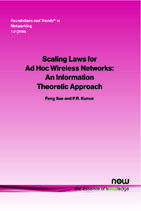Scaling Laws for Ad Hoc Wireless Networks: An Information Theoretic Approach
By Feng Xue, Communications Technology Laboratory/Intel Research, Intel Corporation, USA, feng.xue1@intel.com | P. R. Kumar, Coordinated Science Laboratory, and Department of Electrical and Computer Engineering, University of Illinois, USA, prkumar@uiuc.edu
Abstract
In recent years there has been significant and increasing interest in ad hoc wireless networks. The design, analysis and deployment of such wireless networks necessitate a fundamental understanding of how much information transfer they can support, as well as what the appropriate architectures and protocols are for operating them. This monograph addresses these questions by presenting various models and results that quantify the information transport capability of wireless networks, as well as shed light on architecture design from a high level point of view. The models take into consideration important features such as the spatial distribution of nodes, strategies for sharing the wireless medium, the attenuation of signals with distance, and how information is to be transferred, whether it be by encoding, decoding, choice of power level, spatio-temporal scheduling of transmissions, choice of multi-hop routes, or other modalities of cooperation between nodes. An important aspect of the approach is to characterize how the information hauling capacity scales with the number of nodes in the network.
The monograph begins by studying models of wireless networks based on current technology, which schedules concurrent transmissions to take account of interference, and then routes packets from their sources to destinations in a multi-hop fashion. An index of performance, called transport capacity, which is measured by the bit meters per second the network can convey in aggregate, is studied. For arbitrary networks, including those allowing for optimization of node locations, the scaling law for the transport capacity in terms of the number of nodes in the network is identified. For random networks, where nodes are randomly distributed, and source-destination pairs are randomly chosen, the scaling law for the maximum common throughput capacity that can be supported for all the source-destination pairs is characterized. The constructive procedure for obtaining the sharp lower bound gives insight into an order optimal architecture for wireless networks operating under a multi-hop strategy.
To determine the ultimate limits on how much information wireless networks can carry requires an information theoretic treatment, and this is the subject of the second half of the monograph. Since wireless communication takes place over a shared medium, it allows more advanced operations in addition to multi-hop. To understand the limitations as well as possibilities for such information transfer, wireless networks are studied from a Shannon information-theoretic point of view, allowing any causal operation. Models that characterize how signals attenuate with distance, as well as multi-path fading, are introduced. Fundamental bounds on the transport capacity are established for both high and low attenuation regimes. The results show that the multi-hop transport scheme achieves the same order of scaling, though with a different pre-constant, as the information theoretically best possible, in the high attenuation regime. However, in the low attenuation regime, superlinear scaling may be possible through recourse to more advanced modes of cooperation between nodes. Techniques used in analyzing multi-antenna systems are also studied to characterize the scaling behavior of large wireless networks.
Scaling Laws for Ad-Hoc Wireless Networks
The advent of ad hoc wireless networks demands fundamental understanding about what they can provide in the way of information transfer as well as what the appropriate architectures are for operating them. Scaling Laws for Ad-Hoc Wireless Networks: An Information Theoretic Approach addresses these questions by presenting various models and results that quantify how their information hauling capacity scales with the number of nodes in the network, and also sheds light on high level architecture design for information transport. It begins by studying wireless networks operating under current technology that spatio-temporally schedules transmissions to alleviate interference, and routes packets in a multi-hop fashion. The second half studies wireless networks from a Shannon information-theoretic point of view, allowing any causal operation and more sophisticated modes of nodal cooperation and information transfer over the shared wireless medium. The constructive procedures for obtaining the sharp lower bounds yield insight into order optimal architecture for wireless networks, while the upper bounds provide guidance to designers in assessing how much and how far information can be transported. Scaling Laws for Ad-Hoc Wireless Networks: An Information Theoretic Approach is an invaluable resource for every network engineer or researcher designing or building ad hoc wireless networks.
